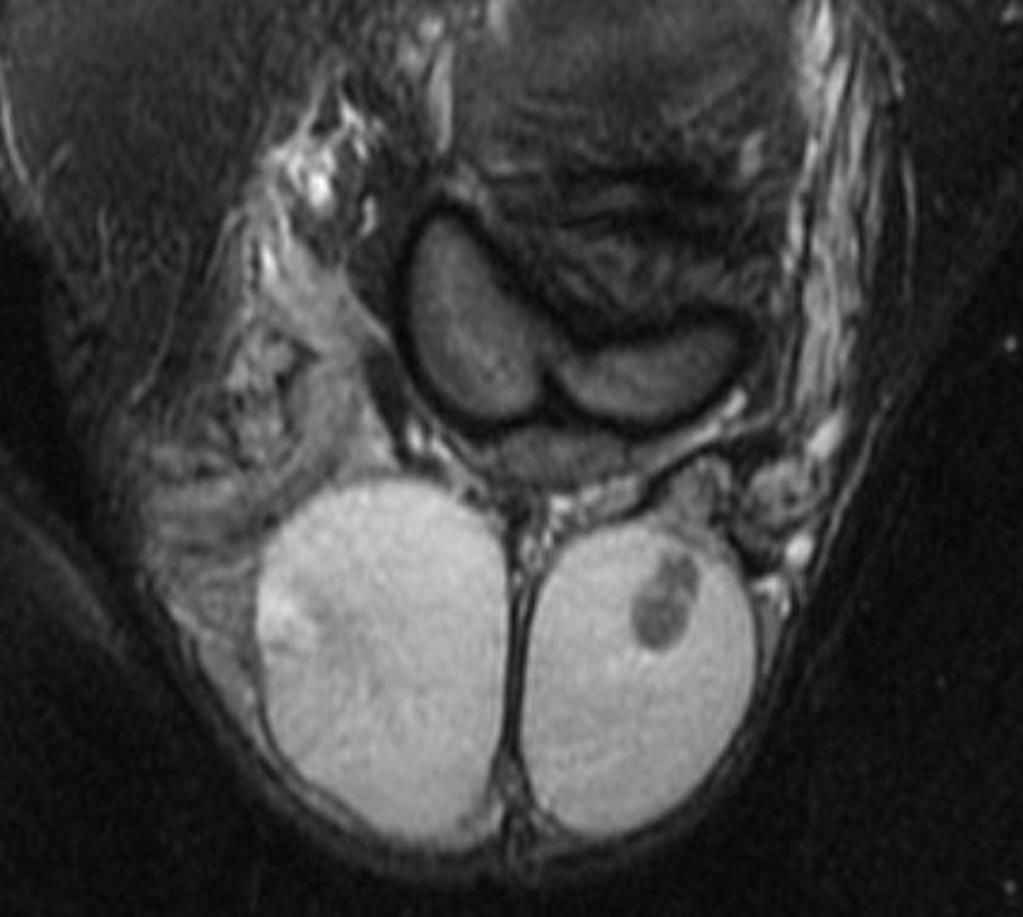Seminoma MRI: Difference between revisions
Jump to navigation
Jump to search
(→MRI) |
|||
| (9 intermediate revisions by the same user not shown) | |||
| Line 1: | Line 1: | ||
__NOTOC__ | __NOTOC__ | ||
{{Seminoma}} | {{Seminoma}} | ||
{{CMG}}{{AE}}{{ | {{CMG}}{{AE}}{{S.G.}} | ||
==Overview== | ==Overview== | ||
Pelvic MRI may be | Pelvic MRI may be helpful in the [[diagnosis]] of seminoma. On [[Magnetic resonance imaging|MRI]], seminoma is characterized by multinodular [[Tumor|tumors]] of uniform [[Signal (biology)|signal]] [[Intensity (physics)|intensity]].In seminoma fibrovascular septa,indicate with low signal intensity on T2-weighted images and more enhance background tumor on postcontrast T1-weighted images. | ||
==MRI== | ==MRI== | ||
{| | Pelvic MRI may be helpful in the diagnosis of seminoma. Findings on MRI diagnostic of seminoma include:<ref name="pmid28574809">{{cite journal |vauthors=Marko J, Wolfman DJ, Aubin AL, Sesterhenn IA |title=Testicular Seminoma and Its Mimics: From the Radiologic Pathology Archives |journal=Radiographics |volume=37 |issue=4 |pages=1085–1098 |date=2017 |pmid=28574809 |pmc=5548453 |doi=10.1148/rg.2017160164 |url=}}</ref><ref name="radiographicimagesofseminoma1">Radiographic features of testicular seminoma. Dr Marcin Czarniecki and Dr Andrew Dixon et al. Radiopaedia 2016. http://radiopaedia.org/articles/testicular-seminoma-1. Accessed on March 7, 2016</ref> | ||
| | *Hypointense to normal [[testicular]] [[Tissue (biology)|tissue]] on T2 | ||
| | *Visualization of fibrovascular septa, which demonstrate low signal intensity on T2-weighted images | ||
*Inhomogeneous enhancement on T1 with [[contrast]] | |||
[[File:Seminoma_in_MRI_(2).jpg|500px|none|thumb|https://en.wikipedia.org/wiki/Seminoma#/media/File:Seminoma_in_MRI_(2).jpg]] | |||
[ | |||
==References== | ==References== | ||
Latest revision as of 14:51, 1 May 2019
|
Seminoma Microchapters |
|
Diagnosis |
|---|
|
Treatment |
|
Case Studies |
|
Seminoma MRI On the Web |
|
American Roentgen Ray Society Images of Seminoma MRI |
Editor-In-Chief: C. Michael Gibson, M.S., M.D. [1]Associate Editor(s)-in-Chief: Sogand Goudarzi, MD [2]
Overview
Pelvic MRI may be helpful in the diagnosis of seminoma. On MRI, seminoma is characterized by multinodular tumors of uniform signal intensity.In seminoma fibrovascular septa,indicate with low signal intensity on T2-weighted images and more enhance background tumor on postcontrast T1-weighted images.
MRI
Pelvic MRI may be helpful in the diagnosis of seminoma. Findings on MRI diagnostic of seminoma include:[1][2]
- Hypointense to normal testicular tissue on T2
- Visualization of fibrovascular septa, which demonstrate low signal intensity on T2-weighted images
- Inhomogeneous enhancement on T1 with contrast

References
- ↑ Marko J, Wolfman DJ, Aubin AL, Sesterhenn IA (2017). "Testicular Seminoma and Its Mimics: From the Radiologic Pathology Archives". Radiographics. 37 (4): 1085–1098. doi:10.1148/rg.2017160164. PMC 5548453. PMID 28574809.
- ↑ Radiographic features of testicular seminoma. Dr Marcin Czarniecki and Dr Andrew Dixon et al. Radiopaedia 2016. http://radiopaedia.org/articles/testicular-seminoma-1. Accessed on March 7, 2016